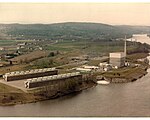Vermont Yankee was an electricity generating nuclear power plant, located in the town of Vernon, Vermont, in the northeastern United States. It generated 620 megawatts (MWe) of electricity at full power. The plant was a boiling water reactor (BWR), designed by General Electric. It operated from 1972 until December 29, 2014, when its owner Entergy shut down the plant. In 2008, the plant provided 71.8% of all electricity generated within Vermont, amounting to 35% of Vermont's electricity consumption. The plant is on the Connecticut River, upstream of the Vernon, Vermont Hydroelectric Dam and used the reservoir pool for its cooling water.
In March 2012, the plant's initial 40-year operating license was scheduled to expire; in March 2011, the Nuclear Regulatory Commission (NRC) extended its license for another 20 years. Vermont Yankee's continued operations were complicated by the Vermont state legislature's enactment of a law providing the state legislature authority to determine the continued operation of the plant, in addition to the federal government. Entergy requested a new state certificate of public good (CPG), but the Vermont legislature voted in February 2010 against renewed permission to operate. In January 2012, Entergy won a court case, invalidating the state's veto power on continued operations. In August 2013, Entergy announced that due to economic factors Vermont Yankee would cease operations in the fourth quarter of 2014. The plant was shut down at 12:12 pm EST on December 29, 2014.
Since the 1970s, there have been many anti-nuclear protests about Vermont Yankee, including large protests after the Fukushima nuclear disaster in March 2011, and on the date of the original operating license expiry in March 2012. The plant's initial operating license from the Nuclear Regulatory Commission was the subject of a lawsuit that produced the U.S. Supreme Court's 1978 decision Vermont Yankee Nuclear Power Corp. v. Natural Resources Defense Council, Inc., in which the Supreme Court set forth a significant doctrine in American administrative law.








